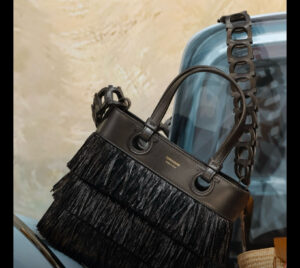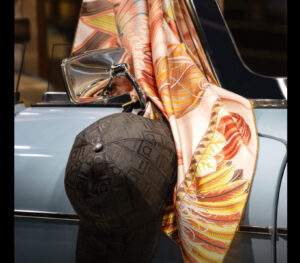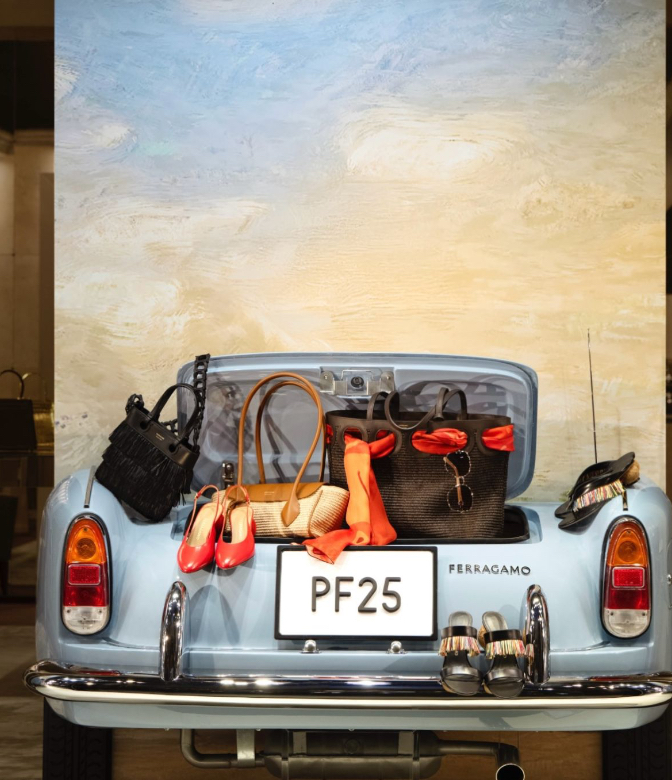



In the dimming light of Florence’s golden hour, a boutique on Via de’ Tornabuoni illuminates with an unusual reverie: a car not made for driving, but for dreaming. The Ferragamo PF25 installation — a cinematic and sculptural display crafted in honor of the Pre-Fall 2025 collection — pulls fashion’s gaze from the runway and parks it into a movie scene reborn. Through six curated windows, Salvatore Ferragamo retells the golden age of Italian cinema — not by resurrecting Fellini or Loren, but by filling the trunk of a handcrafted roadster with handbags, silk scarves, suede loafers, and echoes of La Dolce Vita.
A Scene Set in Resin and Reverie
The life-sized baby blue coupe, placed mid-storefront and mid-nostalgia, anchors the entire installation. It is not merely a prop but a sculpture — molded in fiberglass and finished with chrome details accurate enough to fool any passerby on Via de’ Tornabuoni into a double take. Yet this vehicle will never roar to life. Instead, it holds — like an actress caught mid-monologue — a stillness that vibrates with intention.
On its glossy fenders and in its open trunk lie the protagonists of this curated narrative: meticulously crafted Ferragamo accessories that seem casually tossed, but are in fact masterfully placed. Shoes with polished metal Gancini bits, raffia handbags with leather-draped handles, structured carryalls wrapped in oversized orange satin bows. Each object poses as if for a still from a 1960s Italian film — one in which fashion, not plot, drives the motion.
The PF25 Collection: Accessories as Lead Characters
The Ferragamo PF25 line, designed under the quiet sophistication of Maximilian Davis’ creative direction, is not one of visual bombast but cinematic layering. Each piece is cast like a character with a role to play — some flamboyant, others whispering elegance. In the trunk of the resin car, a black raffia fringe handbag swings with jazz-age confidence, its circular top handles matched by a bold sculptural chain strap. Next to it, red patent flats gleam with mirrored clarity, a nod to Dorothy’s rubies, now Florentine.
The accessories do not sit in the car — they perform. They recline, drape, lounge like divas in repose. A tan straw tote leans against the rear fender, anchored by a leather belt and half-tied scarf. Nearby, a pair of men’s driving shoes in velvet midnight suede nestles in shadow under the antenna. Even the car mirror is adorned with a billowing silk foulard in orange and ochre — a pattern reminiscent of 1960s wallpaper in Capri villas, fluttering as if caught by a fictional breeze.
These are not items to be sold. These are mise-en-scène elements — props in a still life painted with textiles instead of oils.
Window After Window: The Story Unfolds
The visual narrative continues through each boutique window, as if shifting from act to act. One frame reveals the car side-on, its door dressed in camel trench coats and studded mini purses. Another frames the rear, where hats are perched like passengers and scarves act as dialogue — flowing, expressive, and loud with color.
Across from the windows, a full Ferragamo sign glows in embossed gold. The juxtaposition of modern branding and retro romanticism is not dissonant but layered. This is fashion that understands lineage — that sees itself as part of cinema’s prop department, wardrobe archive, and directorial vision all at once.
Craft as Cinema: Details in Focus
The craft is staggering. These aren’t simply window dressings, they are visual essays on Italian excellence:
- The black fringe tote, textured in sharp cascading tiers, glistens under directional lighting that mimics late-day sunlight on a Cinecittà backlot.
- The suede loafers, constructed with Ferragamo’s signature attention to symmetry and leather sourcing, sit perched like a leading man’s monologue: understated but unforgettable.
- The hats — especially the black Gancini-motif baseball cap — are casual only in silhouette. Their stitching, seam work, and fabric composition reveal a formality masquerading as informality.
Here, “luxury” doesn’t scream. It hums — smooth, assured, and quietly timeless, like the glide of a dolly shot across a cobbled Roman street.The License Plate: PF25
The car’s license plate reads “PF25,” a subtle but precise branding nod to the Pre-Fall 2025 season. It functions as both identifier and Easter egg — a wink to those following Ferragamo’s timeline, and a whisper to those new to its lexicon. This is branding that does not intrude but integrates — not a billboard, but a whisper behind a silk curtain.
And of course, the number plate is flanked by Ferragamo’s own badge, embossed not just in metal, but in memory. It evokes not just the name of a brand but the signature of a master shoemaker turned global icon. Salvatore Ferragamo, who once shod Hollywood stars and European nobility, returns in this collection to both domains — crafting an installation where art and utility kiss like old lovers.
Florence as the Prologue and Epilogue
To unveil this installation in Florence is no accident. Florence, the birthplace of Ferragamo, remains one of fashion’s quieter yet most persistent capitals. It is a city where craftsmanship outweighs spectacle and where legacy is carried not in trend but in hand-stitched seams.
In this setting — the windows of the Ferragamo flagship at Via de’ Tornabuoni — the entire PF25 installation feels less like a campaign and more like a poem. It speaks in a language of silk, leather, and resin. It remembers a time when travel was an aesthetic, not just a necessity. When a scarf tied to a mirror meant more than a GPS coordinate — it meant you were headed somewhere beautiful.
A Fashion Tableau, Not Just a Display
This is not a traditional fashion window. This is a tableau vivant: a living still life that merges storytelling and product with architectural sculpture. It challenges the notion that retail space is just commercial real estate. Instead, it presents fashion as something you drive into your memory — something as evocative as a film still.
The car will never move, but the dream it carries will.
Impression
In an era where fast fashion oversaturates the senses and digital runways flicker past in 15-second scrolls, Ferragamo PF25 brings stillness. Not in the absence of movement — but in its reverence for it. Like an Antonioni shot held a second too long, or a Rossellini frame that refuses to blink, this installation asks you not to buy, but to behold.
Hollywood dreams, yes — but crafted in Italy, and parked under the Tuscan light of memory.
No comments yet.








